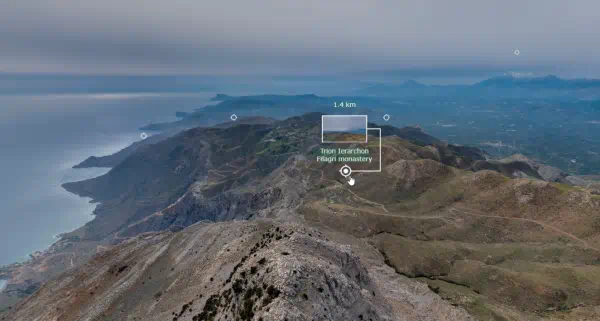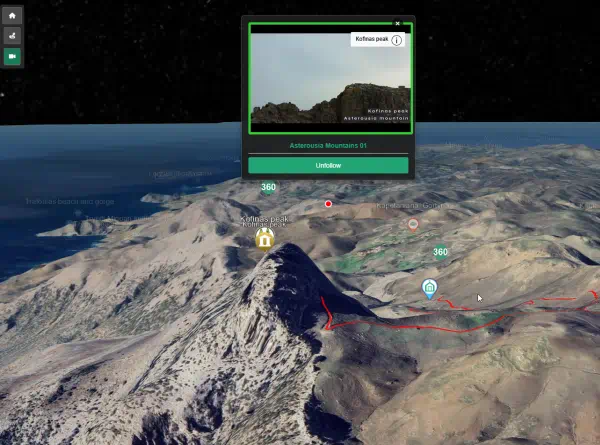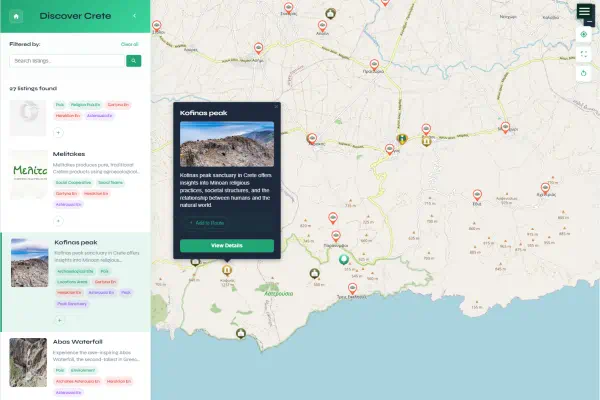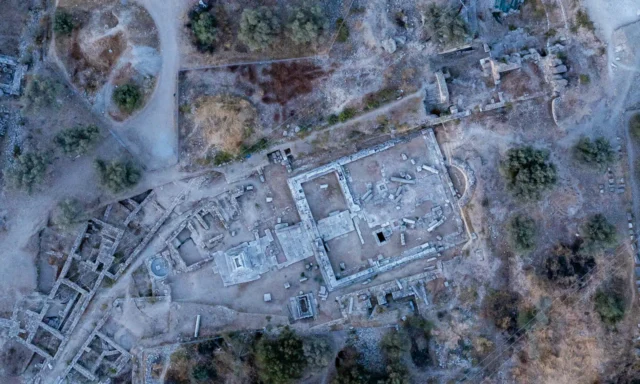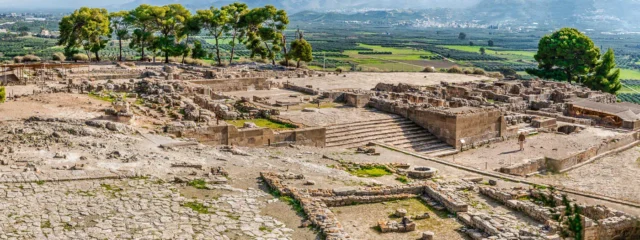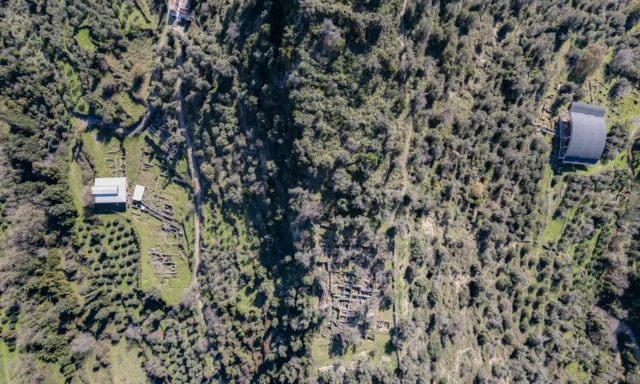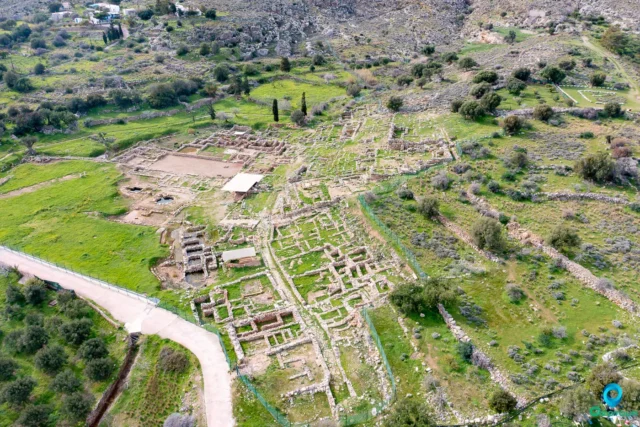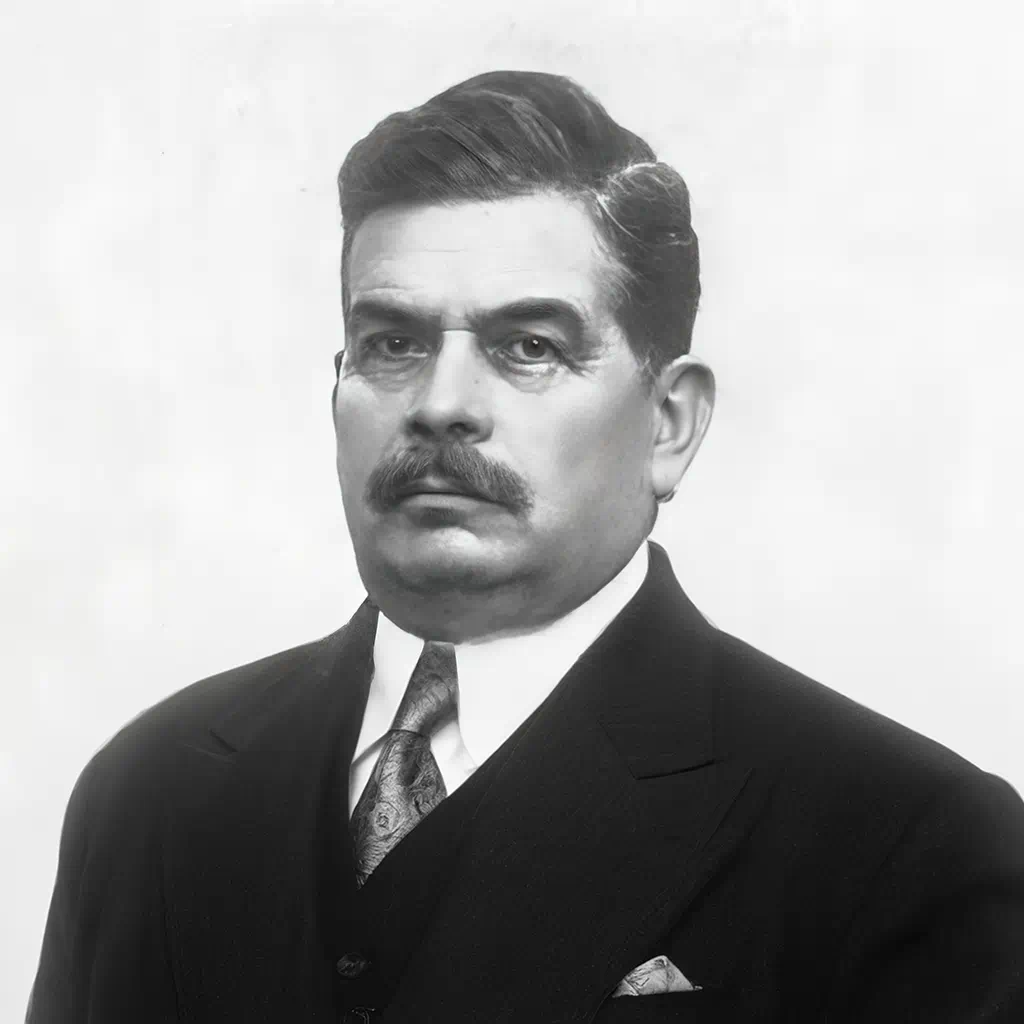Stefanos Xanthoudides
Biography of Stefanos Xanthoudides
Stephanos Antoniou Xanthoudides (1864–1928) stands as a pioneering figure in the development of Greek archaeology, particularly renowned for his lifelong dedication to the exploration, preservation, and scholarly illumination of the multifaceted cultural heritage of Crete. His career unfolded during a transformative period for the island, coinciding with its liberation from Ottoman rule and the establishment of the Cretan State, a context that undoubtedly shaped his endeavors. Xanthoudides’ extensive work spanned numerous epochs, ranging from the earliest phases of the Minoan Bronze Age to the Byzantine era, and encompassed not only meticulous excavation but also insightful publication and tireless efforts to safeguard Cretan antiquities.
His contributions were remarkably diverse. While perhaps best known for his groundbreaking research on the Early Minoan period, particularly the tholos tombs of the Mesara Plain , his archaeological investigations also shed light on Neopalatial ‘villas’ like Nirou Chani and Tylisos , and significantly advanced the understanding of post-Minoan Crete through his work at sites such as Dreros and Axos. Beyond fieldwork, Xanthoudides played an instrumental role, alongside his contemporary Iosif Hatzidakis, in the establishment and early curation of the Heraklion Archaeological Museum, a cornerstone institution for Cretan heritage. His scholarly output was prolific, including the seminal monograph The Vaulted Tombs of Mesara , alongside numerous articles, guidebooks, and significant contributions to Cretan history, folklore, and literature.
A defining characteristic of Xanthoudides’ legacy is his crucial role in broadening the focus of Cretan archaeology beyond the monumental Minoan palaces that captivated early investigators like Sir Arthur Evans. By systematically exploring Early Minoan cemeteries and later Iron Age settlements, he provided essential data for constructing a more comprehensive and nuanced narrative of the island’s long and layered past. His deep commitment to his homeland’s cultural legacy was evident not only in his scholarly pursuits but also in his active advocacy for the preservation of historical monuments. The emergence of his career during Crete’s transition to autonomy provided a unique backdrop; his work in uncovering and defining the island’s past was intrinsically linked to the broader project of asserting a distinct Cretan cultural identity within a new political reality, positioning him not merely as an academic but as a key figure in cultural nation-building. This report aims to provide a comprehensive, analytical overview of Stephanos Xanthoudides’ archaeological contributions and enduring legacy, synthesizing the available information to address his specific excavations, institutional roles, scholarly impact, and overall significance in the field of Cretan studies.
Formative Years and Early Career: From Scholar to Ephor
Stephanos Xanthoudides was born in the village of Avdou, near Heraklion, Crete, in 1864. His upbringing occurred during a challenging period, yet his father, the painter Antonios Xanthoudides (1819–1896), held a strong belief in the power of education and managed to send Stephanos and his four brothers to Heraklion and subsequently to Athens for higher studies. Stephanos completed his initial studies at the Hellenic School of Heraklion before moving to the University of Athens. There, he pursued studies in Philosophy and Philology, discovering a passion for scientific research and earning his Literature Degree in 1888.
Upon returning to Crete, Xanthoudides embarked on a career as a teacher at the Hellenic School of Heraklion. He quickly gained recognition as a wise and effective educator, remembered by former students for his methodical teaching style and distinctive deep voice. This early phase highlights a broad humanistic foundation rooted in philosophy and philology, which likely provided a unique perspective when he later turned his focus fully to archaeology and related fields. His subsequent work in archaeology, folklore, history, and literary studies suggests that this initial interdisciplinary training fostered a holistic approach to understanding Cretan culture, allowing him to perceive connections across different domains of human activity and expression.
The political transformation of Crete at the turn of the century marked a pivotal point in Xanthoudides’ career. Following the island’s liberation from Ottoman rule and the establishment of the Cretan State, he was appointed Ephor of Antiquities in 1899, a significant position he held for fifteen years. (Later sources refer to him as Ephor General of Antiquities ). This role placed him at the forefront of managing the island’s rich archaeological heritage during a critical period of burgeoning excavation activity by both Cretan and foreign scholars. His responsibilities involved overseeing the organization and preservation of numerous archaeological sites and artifacts across Crete. However, his tenure was far from purely administrative. Xanthoudides actively combined his official duties with extensive personal archaeological research and a strong commitment to monument preservation. He energetically advocated for the protection of landmarks such as the Venetian Loggia in Heraklion and successfully intervened in 1924 to prevent the conversion of the historic Saint Titus church into an English Telegraph Office, ensuring its restoration as an Orthodox temple. This dual capacity as both administrator and active field researcher provided him with unparalleled island-wide knowledge and the authority to pursue a broad research agenda, demonstrating a synergy between his bureaucratic position and his scholarly drive.
His role also involved significant collaboration. He worked alongside the Italian Archaeological Mission, particularly Federico Halbherr, and his Cretan colleague Joseph Hatzidakis in investigations at Gortyn, notably intervening after the chance discovery of the Great Law Code inscription in 1884 and later working on the ruins of the Saint Titus church around 1900. He also co-authored survey reports with Halbherr and others, published in the American Journal of Archaeology between 1896 and 1901, indicating his early engagement with the international scholarly community.
Collaboration with Hatzidakis and the Heraklion Archaeological Museum
The establishment of the Heraklion Archaeological Museum, now one of the most significant museums in Greece renowned for its Minoan collections , was a crucial development in early 20th-century Cretan archaeology, intrinsically linked to the careers of both Stephanos Xanthoudides and Iosif Hatzidakis. The museum’s origins trace back to 1883, during the period of Ottoman rule, when Hatzidakis (a physician and antiquarian) initiated the first archaeological collection under the auspices of the local Association of Friends of Education. Hatzidakis also secured permission to establish the first ‘archaeological service’. This initial collection, housed modestly in two rooms at the Saint Minas cathedral, grew steadily through donations, acquisitions, and finds from early surveys and small excavations.
Around 1900, coinciding with the dawn of large-scale, systematic excavations across Crete by figures like Arthur Evans, Federico Halbherr, Harriet Boyd Hawes, Richard Seager, and the Cretan archaeologists themselves , the burgeoning collection required more formal oversight. Hatzidakis and Xanthoudides became the first Keepers of Antiquities for the newly autonomous Cretan State, and the collection was transferred to state control, temporarily housed in the former Turkish Barracks.
Recognizing the inadequacy of these arrangements and the increasing influx of major discoveries, Hatzidakis and Xanthoudides were the driving forces behind the construction of the first dedicated museum building. This structure was erected in phases between 1904 and 1912 on the site of the Venetian Monastery of Saint Francis, which had been destroyed by an earthquake in 1856. The initial display room (1904-1907), designed by Wilhelm Dörpfeld and Panagis Kavvadias , was followed by a second room in 1908, allowing the transfer of the collection from the Barracks. A west wing, giving the building a Neoclassical facade, was added in 1912. Xanthoudides played a vital role not only in advocating for the museum but also in its practical organization, curating the growing collection and authoring the museum’s first guidebook. A later publication from 1933 includes a guide attributed to him as the late Director.
The successful establishment and growth of the Heraklion Museum during this period cannot be separated from the simultaneous explosion of archaeological fieldwork on the island. The major excavations generated an unprecedented volume of artifacts requiring professional curation and storage, thus necessitating the museum’s creation and expansion. Conversely, the museum provided a vital repository and showcase, legitimizing the archaeological endeavors and concentrating the island’s heritage. Hatzidakis and Xanthoudides were central figures navigating this symbiotic relationship, involved in both the acquisition of artifacts (through their own work and oversight of others) and the institutional development required to manage them.
Furthermore, the legal framework established at the time played a critical role. The Cretan antiquities law of 1899, notably drafted by Hatzidakis and Xanthoudides themselves, was foundational. By asserting Cretan ownership over all antiquities discovered on the island and prohibiting their export, the law ensured that the wealth of material unearthed by both Cretan and numerous foreign archaeological missions (British, Italian, American) would remain in Crete. This legislative act, implemented by the very individuals championing the museum, directly facilitated the accumulation of the extraordinary collection that would define the Heraklion Archaeological Museum and secure its international importance.
The Koumasa Cemetery Excavations (1904-1906)
Among Stephanos Xanthoudides’ most significant contributions to Cretan archaeology was his meticulous excavation of the Prepalatial cemetery complex at Koumasa. Situated strategically at the northern foot of the Asterousia Mountains overlooking the fertile Mesara plain, between the modern villages of Loukia and Koumasa , the site was destined to play a key role in the region during the Early Bronze Age. Xanthoudides undertook his investigations here between 1904 and 1906 , reportedly prompted after a local peasant brought him a small number of artifacts—sealstones, beads, and dagger fragments—found at the site. His work uncovered not only the cemetery but also part of an associated settlement on an adjacent hill. The site later saw renewed investigations by A. Kanta and A. Karetsou in 1991–1992 and by D. Panagiotopoulos from 2012 onwards.
The cemetery complex excavated by Xanthoudides comprised four main funerary structures: three circular tholos tombs (designated B, E, and A) and one rectangular ossuary-like tomb (Gamma). The tholos tombs are exemplary of the Early Minoan Mesara architectural tradition. These structures were typically built above ground with thick circular walls of unworked stones bonded with clay, enclosing a burial chamber. Evidence suggests they were originally corbelled, with successive courses of stone projecting inwards to form a beehive-shaped dome, although Xanthoudides speculated that Tholos B might have had a partially removable roof based on evidence of a central hearth and a possible smoke hole. Entrances, usually simple openings possibly sealed with slabs, consistently faced towards the east.
Tholos B, the largest and most complex of the Koumasa tombs, possessed an internal diameter of 9.52 meters and walls between 1.60 and 2.0 meters thick, giving an impressive external diameter of around 13.50 meters. It was constructed directly on the bedrock. Xanthoudides recorded a unique double entrance divided by a large upright stone, although later re-investigation and restoration work in the 1970s apparently reduced this to a single opening, raising questions about the original interpretation. East of Tholos B, Xanthoudides identified a paved court area, suggesting an external space for associated activities.
The excavations revealed evidence for complex funerary practices involving multiple, successive interments over a considerable period; the sheer quantity of disarticulated human bones found within Tholos B suggested to Xanthoudides that hundreds of individuals had been buried there. The commingled state of the bones indicated secondary manipulation—remains were likely moved aside or collected, perhaps in associated annexes or the rectangular tomb, to make space for new burials or possibly disturbed during episodes of looting. Xanthoudides also noted signs of ritual activity involving fire within Tholos B, including blackened bones and traces of a large hearth.
Despite evidence of ancient looting, Xanthoudides recovered a remarkable array of grave goods that attested to the wealth, sophistication, and external connections of the Prepalatial community using the cemetery. The finds provide a vivid picture of Early Minoan material culture (primarily EM IIA, based on pottery styles like the eponymous Koumasa ware ) and funerary customs. Key discoveries included:
- Pottery: Characteristic Early Minoan IIA Koumasa style vessels, including jugs, pyxides (cylindrical boxes), lamps, and distinctive anthropomorphic and zoomorphic vases.
- Stone Vessels: A large number of finely crafted stone items, considered more significant by Xanthoudides than the pottery finds. These included numerous small table-like objects (perhaps offering tables, though lacking colour traces seen on Cycladic palettes), composite vessels known as kernoi, ‘bird’s nest’ bowls, and other bowl types, many likely dating to EM III or MM I. Abundant obsidian blades were also recovered.
- Figurines: A notable clay figurine depicting a bull-leaping scene, hinting at the early origins of this iconic Minoan motif and associated rituals. Several Cycladic figurines, mostly schematic representations of naked females, were found; some carved from imported island marble, others from local limestone, potentially representing local imitations or adaptations of Cycladic types, perhaps linked to a Mother Goddess concept. Some showed signs of deliberate breakage before deposition. Cretan-style figurines, predominantly depicting women in long dresses with hands on breasts, dating to EM IIA, were also present.
- Jewelry: Indicative of considerable wealth and access to precious materials, finds included gold jewelry such as beads, bands of gold sheeting, and a unique microscopic gold pendant shaped like a crouching frog. This frog pendant, perhaps used as an amulet, finds parallels in Pharaonic Egypt where the frog symbolized rebirth, suggesting possible ideological connections or shared symbolism. Necklaces and pendants made from steatite and other materials were also common.
- Weapons and Tools: Metal finds included three silver daggers and over twenty copper or bronze daggers of both short triangular and longer types, suggesting daggers were common personal accoutrements. Small bronze tools like cutters, tweezers, pins, and awls were also discovered.
- Seals: Approximately twenty seals made from ivory or stone were found, featuring various designs. A particularly fine example depicted a dove sheltering its young, showcasing skilled craftsmanship.
The Koumasa excavations were profoundly significant. They provided unparalleled insights into the society, funerary ideology, and material world of Early Minoan Crete, a period less understood at the time compared to the later palatial eras. The finds challenged notions of a simple, undeveloped Prepalatial society. The monumental tomb architecture pointed to sophisticated engineering skills and organized communal effort. The rich and diverse grave goods, including precious metals and imports like Cycladic figurines and obsidian, indicated considerable wealth accumulation, established trade networks reaching the Cyclades and possibly further afield (Egypt/Near East for raw materials and perhaps ideas) , and likely emerging social differentiation within the community. The evidence for long-term use, communal burial, secondary bone manipulation, and possible associated rituals illuminated complex beliefs surrounding death and ancestry.
Crucially, Xanthoudides ensured the impact of these discoveries through publication. His comprehensive monograph, Archaiologikē Ephēmeris reports, and culminating work The Vaulted Tombs of Mesara, published in English translation in 1924 with a preface by the influential Sir Arthur Evans, became a cornerstone of Minoan studies. This strategic dissemination ensured that the rich evidence for Prepalatial civilization from Koumasa and other Mesara sites entered the mainstream international archaeological discourse, providing a vital counterpoint and foundation to the dominant narrative focused on Evans’ palatial discoveries at Knossos. It firmly established the importance of the Early Minoan period and Xanthoudides’ fundamental contribution to its understanding.
The following table summarizes selected key finds from Xanthoudides’ original excavations, highlighting the diversity and significance of the assemblage:
Selected Key Finds from Xanthoudides’ Koumasa Excavations (1904-1906)
Category | Description/Type | Material | Significance/Context |
Pottery | Koumasa style vessels (jugs, pyxides, etc.) | Clay | EM IIA dating; Regional style |
Anthropomorphic/zoomorphic vases | Clay | Ritual/Special function; Artistic expression | |
Stone Vessels | Small table-like objects | Stone | Offering tables? Ritual function |
Kernoi (multiple vessels) | Stone | Ritual function (libations?) | |
Bird’s nest bowls, other bowls | Stone | High craft skill; Common EM types | |
Obsidian blades | Obsidian | Imported material (Melos); Tools | |
Figurines | Bull-leaping scene | Clay | Early evidence for iconic Minoan ritual/motif |
Cycladic type, naked female | Marble/Stone | Cycladic imports/influence; Possible goddess representation; Some ritually broken | |
Cretan type, dressed female | Clay | Local style; EM IIA dating | |
Jewelry | Microscopic frog pendant | Gold | Exquisite craft; Amuletic?; Possible Egyptian connection/parallel |
Beads, sheeting bands | Gold | Indicator of wealth; Personal adornment | |
Pendants, necklaces | Steatite, etc. | Common adornment | |
Weapons/Tools | Daggers | Silver | Rare precious metal; High status |
Daggers (triangular & long types) | Copper/Bronze | Common male grave good; Indicator of status/role | |
Tweezers, pins, awls, cutters | Copper/Bronze | Tools/Personal items | |
Seals | Various designs (e.g., dove protecting young) | Ivory, Stone | Administrative/Personal identity markers; Artistic expression; Craft specialization |
Work at Tylisos
The important Minoan site of Tylisos, located southwest of Heraklion on the route towards Mount Psiloritis (Ida) , offered significant insights into elite life outside the major palatial centers during the Neopalatial period. Although traces of the Minoan town were noted earlier, systematic excavations were first undertaken by Joseph Hatzidakis between 1909 and 1913. Hatzidakis uncovered three substantial buildings, designated Houses A, B, and C, which are generally interpreted as elite residences or ‘villas’. His findings were subsequently published.
These structures primarily dated to the Neopalatial period, specifically from the end of Middle Minoan III to Late Minoan IB (roughly 1600–1450 BCE), when they were destroyed by fire, concurrently with many other major Minoan sites across Crete, excluding Knossos. The site showed evidence of earlier occupation phases (EM II to MM II) and was reoccupied later, in LM IIIA. Hatzidakis’ work revealed buildings possessing distinct palatial characteristics, such as the use of fine ashlar masonry, the presence of a ‘Minoan Hall’ system (a main hall adaptable with pier-and-door partitions, often associated with a light well), and magazines containing large storage pithoi (over 50 were found throughout House A alone). House A was a particularly large, originally two-storey mansion with distinct storage and residential zones; House B was simpler, perhaps an annex; and House C was a well-preserved Neopalatial mansion sealed by destruction debris. The site also yielded evidence of later LM III activity, including a cistern accessible by steps and an aqueduct with clay pipes. The importance of Tylisos in Minoan times is further underscored by its mention in Linear B administrative texts found at Knossos.
Stephanos Xanthoudides also conducted investigations at Tylisos, following Hatzidakis’ initial campaigns. This later phase of work is noted as occurring between 1923 and 1925 (User Query). However, the available source materials focus almost exclusively on the results of Hatzidakis’ excavations and the general description and significance of the site as revealed by that earlier work. No specific details regarding the focus, methods, or findings of Xanthoudides’ investigations during the 1923–1925 period are provided in these sources. Therefore, while his involvement at Tylisos during this timeframe is acknowledged, the specific nature and outcomes of his contribution there cannot be elaborated upon based solely on the provided documentation. His work presumably built upon Hatzidakis’ discoveries, potentially clarifying aspects of the site’s stratigraphy, architecture, or later occupation phases, but the evidence to confirm this is absent in the supplied texts.
Excavations at Dreros (1917)
Stephanos Xanthoudides’ intellectual curiosity extended beyond the Minoan civilization, leading him to initiate the first archaeological excavations at the important post-Minoan site of Dreros in 1917. Located near modern Neapoli in the Mirabello district of eastern Crete , Dreros occupies two small peaks and the saddle between them. Archaeological evidence indicates the city was founded during the Geometric period and flourished particularly between the 8th and 6th centuries BCE (Archaic period), before becoming allied with, and later dependent on, Knossos in the Hellenistic period and continuing to be occupied into Byzantine times. The site comprises two acropoleis, an agora, and traces of fortification walls. Inscriptions found at the site are in the Dorian dialect, confirming its post-Minoan Greek character.
Xanthoudides’ pioneering work in 1917 opened the door for subsequent, more extensive investigations by the French School under Pierre Demargne and Henri van Effenterre, starting in 1932, and by Spyridon Marinatos, who excavated the Temple of Apollo in 1935. These later excavations yielded some of the most significant finds from the site. Notably, the Temple of Apollo Delphinios, situated southwest of the agora, was revealed to be one of the earliest known Greek temples, constructed around 750 BCE. Within its precincts, Marinatos discovered three remarkable bronze statuettes crafted using the sphyrelaton technique (hammered bronze sheets over a wooden core). Dating to around 650 BCE (early Archaic/Orientalizing period), these figures, now housed in the Heraklion Archaeological Museum, likely represent Apollo, his mother Leto, and his sister Artemis, collectively known as the “Dreros Triad”. Another major discovery, made by the French excavators in the fill of a later Hellenistic cistern, was a group of Archaic inscriptions. Among these is the famous “sacred law of Dreros,” inscribed on stone blocks, which constitutes the earliest complete record of constitutional law yet found in Greece, providing invaluable insights into the political organization of an Archaic Cretan city-state.
While the available sources clearly credit Xanthoudides with initiating the excavations in 1917 , they do not specify which, if any, of these major discoveries were made during his initial campaign. The Temple of Apollo itself was excavated later by Marinatos , and the inscriptions were found by the French team. One source does note, based on a re-examination of pottery from the French-Greek excavations, that Xanthoudides had initially identified a structure on the west acropolis as a sanctuary, an interpretation supported by the later ceramic analysis, contrasting with Marinatos’ subsequent hypothesis that it was an andreion (civic feasting hall). This indicates Xanthoudides engaged in early interpretation of the site’s structures. Despite the lack of specific details on his 1917 finds in the provided texts , his act of initiating work at Dreros was of paramount importance.
The decision to excavate Dreros demonstrates Xanthoudides’ commitment to a comprehensive understanding of Cretan history, extending his focus beyond the Bronze Age into the critical Geometric and Archaic periods. This work complemented his research into the island’s earliest phases, contributing significantly to bridging the gap between Minoan civilization and the later Classical era. By identifying the potential of Dreros, he effectively opened up a crucial site for understanding the Cretan ‘Dark Age’ transition and the formation of the Dorian city-states, paving the way for the significant discoveries made by later excavators. His pioneering role lay in recognizing the site’s importance and undertaking the initial exploration, setting the stage for future research that would profoundly illuminate this later chapter of Cretan history.
The following table summarizes the key discoveries at Dreros mentioned in the sources, attributing them where possible:
Key Discoveries at Dreros
Discovery | Period | Description | Significance | Excavator(s) |
Initial Excavation | 1917 | First systematic investigation of the site | Opened the site for archaeological research | S. Xanthoudides |
Sanctuary Identification | Geometric/Archaic | Identification of a sanctuary structure on the West Acropolis (vs. later andreion hypothesis) | Early interpretation of site function, later supported by ceramic evidence | S. Xanthoudides |
Temple of Apollo Delphinios | ca. 750 BCE | One of the earliest known Greek temples | Crucial evidence for early Greek religious architecture | S. Marinatos (1935) |
“Dreros Triad” Statuettes | ca. 650 BCE | Three sphyrelaton figures (Apollo, Leto, Artemis?) found in temple precincts | Important examples of early Archaic hammered bronze sculpture | S. Marinatos (1935) |
Archaic Law Inscriptions | Archaic | Group of inscriptions found in Hellenistic cistern fill, including the “sacred law of Dreros” | Earliest complete Greek constitutional law; Insight into Archaic Cretan polis | French School (Demargne/Effenterre) |
Fortification Traces | Geometric/Archaic | Remains of city walls | Evidence for defensive structures |
Contributions to Diverse Sites and Periods
Stephanos Xanthoudides’ archaeological endeavors extended far beyond the well-known sites of Koumasa, Tylisos, and Dreros, reflecting a comprehensive approach to uncovering Crete’s past across various regions and time periods. His extensive fieldwork included excavations at the Minoan mansion of Nirou Chani, the ancient city of Axos, and further work on the tholos tombs of the Mesara Plain, among others.
Nirou Chani: In 1918, Xanthoudides excavated the significant Minoan building at Nirou Chani, located on the north coast east of Heraklion near modern Kokkini Chani. Often referred to as a ‘villa’, ‘mansion’, or even ‘Megaron Nirou’ or ‘little Palace’, this substantial structure (approx. 1000 sq m ground floor area with 40 rooms and two courtyards) dates from the late Middle Minoan III or early Late Minoan IA period and met its end in a fiery destruction during LM IB (ca. 1450 BCE). The building exhibited many features associated with palatial architecture, including ashlar masonry, gypsum dadoes, frescoes (including fragments identified by Evans as depicting ‘sacral knots’), and a Minoan Hall system opening onto the east court. The east court itself featured a raised platform or altar, compared by Xanthoudides to the ‘theatral areas’ of Knossos and Phaistos.
The finds from Nirou Chani were particularly striking and fueled ongoing debate about the building’s function. Xanthoudides unearthed dozens of terracotta tripod offering tables or altars stacked in storerooms (Rooms 16-18), four large bronze double axes (in Room 7), and various stone lamps and vases. The sheer quantity of ritual paraphernalia, seemingly exceeding the needs of the building itself, led Xanthoudides and Evans to suggest it might have been the residence of a high priest or a center for the production and distribution of cult objects for export. Other interpretations have included a seat for a local ruler, a trade center, or even a Minoan andreion (a communal feasting hall for initiated males, suggested by R. Koehl based on Hall 12). The lack of administrative evidence, such as seals, sealings, or Linear A tablets, is notable. Its coastal location and proximity to the Vathianos River suggest connections to maritime trade and potentially the major centers of Knossos and Malia, or the port of Amnisos. Xanthoudides’ excavation thus provided crucial early data contributing to the complex scholarly discussion surrounding the function and status of these non-palatial elite Minoan buildings (‘villas’) and their role within the broader Neopalatial socio-political landscape.
Axos: Xanthoudides is also credited with conducting excavations at the ancient city of Axos. However, the provided source materials, while mentioning his work there, offer no specific details regarding the timeframe, nature, or findings of these excavations. Axos is known from other sources to have been an important city, particularly in the Geometric, Archaic, and later periods, so his work there likely contributed to the understanding of post-Minoan Crete, complementing his investigations at Dreros, but the specifics remain undocumented in the available texts.
Mesara Plain Tholos Tombs: Building on his work at Koumasa, Xanthoudides undertook pioneering research on other Early Minoan tholos tomb cemeteries in the Mesara. Between 1914 and 1915, he excavated three large tholos tombs at Platanos. He also investigated the tholos tomb at Porti and discovered another vaulted tomb near Kalathiana in 1908, where he later excavated a Protopalatial settlement (1912-1914). This focused research program across multiple sites solidified the understanding of the distinctive Mesara tholos tomb tradition as a hallmark of the Early Minoan period in southern Crete. His collective work revealed a wealth of information about communal burial practices, the evolution of tomb architecture, Early Minoan material culture (pottery, jewelry, weapons, stone vases, seals), and the social dynamics of these Prepalatial communities.
Analysis Across Periods: Xanthoudides’ selection of excavation sites appears to reflect a deliberate strategy to investigate Cretan civilization across its chronological and geographical breadth. By targeting Early Minoan cemeteries in the Mesara (Koumasa, Platanos, Porti), Neopalatial elite centers on the north coast (Nirou Chani, Tylisos), and post-Minoan cities in different regions (Dreros in Mirabello, Axos potentially in the Mylopotamos valley), he moved beyond a single-site or single-period focus. This approach allowed him to make fundamental contributions to understanding distinct phases of Cretan history:
- Early Minoan (Prepalatial): His work was foundational, establishing the architectural forms, burial customs, material culture, external connections (Cyclades, possibly Egypt/Near East), and social complexity (communal organization, wealth differentiation) of the period preceding the palaces.
- Neopalatial: Investigations at Nirou Chani and Tylisos contributed data to the study of the ‘villa’ phenomenon, illuminating the architecture, potential functions (ritual, residential, administrative, trade), and regional importance of elite centers operating alongside or subordinate to the major palaces.
- Geometric & Archaic: Initiating work at Dreros and likely Axos was crucial for shedding light on the island’s history after the decline of Minoan civilization, revealing early developments in Greek temple architecture, sculpture, and legal/political structures in Dorian Crete.
Overall, Xanthoudides played an indispensable role in constructing a more complete and diachronic understanding of Cretan history. His research provided crucial data points for the beginning and later phases of the island’s ancient trajectory, effectively bookending the intense focus on the Neopalatial period driven by his contemporaries, and contributing significantly to a more comprehensive appreciation of Crete’s uniquely rich and layered past.
Publications and Wider Interests
Stephanos Xanthoudides was far more than a field archaeologist; he was a dedicated and multifaceted scholar whose contributions extended into history, literature, folklore, and language studies, reflecting a deep and holistic engagement with Cretan culture. His scholarly output was characterized by meticulous documentation, clarity, precision, and insightful interpretation.
In archaeology, his publications were foundational. He meticulously documented his excavations, producing detailed reports and analyses. His most celebrated archaeological work is undoubtedly The Vaulted Tombs of Mesara. Published in English translation in 1924 (following earlier Greek publications), with a preface by Sir Arthur Evans, this volume presented the results of his extensive excavations at Koumasa, Platanos, and other Early Minoan cemeteries in the Mesara. It is considered the best of his archaeological publications and remains an indispensable reference for the study of the Prepalatial period, Mesara tholos architecture, and Early Minoan funerary practices. Its frequent citation in subsequent scholarship attests to its enduring importance. Beyond this magnum opus, he authored numerous articles on his various excavations (e.g., Nirou Chani , Pyrgos cave ) and collaborated on early survey reports published in the American Journal of Archaeology. Recognizing the need for public outreach, he also wrote accessible guidebooks on Cretan archaeology and history, including the first guidebook for the Heraklion Archaeological Museum. This effort to popularize Cretan heritage was particularly significant in the early 20th century as Crete integrated more fully into Greece.
Xanthoudides’ philological and literary scholarship also garnered significant recognition. His critical edition of Vitsentzos Kornaros’ 17th-century masterpiece, the epic romance Erotokritos, published in 1915, was the culmination of six years of intensive research. This edition included not only the meticulously prepared text but also an extensive glossary, grammatical analysis, and detailed information on the poet, the historical context, and previous scholarship. It achieved international acclaim and remains a landmark contribution to the study of Cretan Renaissance literature. His interpretation viewed Erotokritos as a skillful blend of folk traditions and individual poetic creation. He also published editions of other important Cretan literary works, such as Marco Foskolo’s comedy Fortunato and the 16th-century poem Fallido (1922).
His deep interest in the living culture of Crete led him to make substantial contributions to folklore and dialect studies. He diligently collected and published numerous Cretan folk tales, songs, and proverbs, preserving vital aspects of the island’s oral tradition. He authored papers on the Cretan dialect and presented an essay on the interpretation of Cretan surnames in 1923. Some of his work in this area reportedly remains unpublished.
In the realm of history, Xanthoudides focused particularly on the Venetian period in Crete. He published essays such as “Cretan Contracts from the Venetian Period” (1912) and made significant contributions based on his study of Christian inscriptions (1903) to Giuseppe Gerola’s major work on Venetian monuments in Crete, a contribution Gerola considered equivalent to collaboration. His most important historical work, a study of Venetian rule and the Cretan resistance against it, earned an award from the University of Athens in 1925 and was published posthumously in 1939.
Xanthoudides’ wide-ranging activities across archaeology, history, literature, folklore, and language studies mark him as a foundational figure in the holistic study of Crete. His work transcended disciplinary boundaries, aiming for a comprehensive understanding of the island’s culture and history through time. This integrated approach has led to him being characterized as the “First scientist Cretologist, the Nestor of Cretan Studies” , recognizing his role in establishing Cretology as a serious, multifaceted field of scientific inquiry. Furthermore, his commitment to both rigorous academic publication and accessible writing (guidebooks, articles) demonstrates a conscious effort to bridge the gap between specialized scholarship and public knowledge, contributing to cultural education and identity formation in early 20th-century Crete. He also actively fostered an intellectual community by encouraging and supporting the work of other scholars.
Legacy and Impact on Cretan Archaeology
Stephanos Xanthoudides left an indelible mark on the field of Cretan archaeology and broader Cretan studies. He is rightly remembered as a groundbreaking figure, a pioneer who laid essential groundwork for subsequent generations of scholars exploring the island’s rich past. His multifaceted career, combining meticulous fieldwork, insightful scholarship, institutional development, and cultural advocacy, established him as a central figure in the formative years of the discipline on the island, earning him accolades such as the “First scientist Cretologist” and the “Nestor of Cretan Studies”.
Perhaps his most significant archaeological legacy lies in his deliberate expansion of the field’s scope beyond the grand Minoan palaces that dominated early interest, largely due to the work of Sir Arthur Evans at Knossos. Xanthoudides’ systematic investigations into the Early Minoan period, particularly his extensive work on the Mesara tholos tombs (Koumasa, Platanos, Porti, etc.), provided the first substantial body of evidence for the island’s Prepalatial past. This research, culminating in his seminal publication The Vaulted Tombs of Mesara , demonstrated the sophistication and complexity of Cretan society long before the rise of the palaces, revealing developed funerary rituals, distinct architectural traditions, craft specialization, external contacts, and emerging social hierarchies. His work effectively established the deep indigenous roots of Minoan civilization.
Simultaneously, his excavations at sites like Dreros and Axos pushed the chronological boundaries forward, illuminating the crucial transitional periods of the Early Iron Age (Geometric and Archaic). By uncovering early Greek temple architecture, unique sphyrelaton sculpture, and vital legal inscriptions at Dreros , he provided key insights into the island’s history after the decline of the Bronze Age palaces. This focus on both earlier and later periods created a more balanced and comprehensive understanding of Crete’s long-term cultural trajectory, complementing Evans’ focus on the Neopalatial era and establishing the island’s continuous historical significance.
Xanthoudides’ approach to fieldwork and publication was characterized by meticulousness, precision, and clarity. Although excavation techniques have evolved considerably since the early 20th century , the quality of his documentation and the thoroughness of his publications have ensured the enduring relevance of his work. Modern archaeological projects at sites he first investigated, such as the renewed excavations and studies at Koumasa and the re-examination of material from Dreros , explicitly engage with, build upon, and sometimes re-evaluate his original findings and interpretations. This demonstrates that he provided a robust foundation upon which later research could develop, a testament to his scholarly rigor.
His institutional legacy is embodied primarily in the Heraklion Archaeological Museum, which he co-founded with Iosif Hatzidakis. This institution remains the principal repository for Minoan artifacts and a vital center for Cretan archaeological research. His influence extended to later generations of archaeologists; the naming of the LM III “Xanthoudidis Painter” explicitly honors his contributions , and figures like Spyridon Marinatos, who later directed the Heraklion Museum and conducted major excavations himself (including at Dreros), worked under Xanthoudides early in his career. Xanthoudides also actively collaborated with international scholars like Federico Halbherr and Giuseppe Gerola , and his work gained international recognition through translations and publications abroad. His commitment to preserving Crete’s heritage was also manifest in his successful efforts to protect historical monuments like the Loggia and Saint Titus church in Heraklion.
Stephanos Xanthoudides passed away suddenly from cardiac arrest on September 18, 1928, at the age of 64, while walking towards the Archaeological Museum in Heraklion, the institution he had helped to build. His death marked the end of a remarkably productive and influential career dedicated to the comprehensive exploration and understanding of Cretan culture and history.
The following table provides a chronological overview of some key events and activities in Stephanos Xanthoudides’ life and career, based on the provided sources:
Chronology of Stephanos Xanthoudides’ Key Activities
Year(s) | Activity/Event | Site/Context | Significance |
1864 | Born | Avdou village, Crete | |
by 1888 | Studied Philosophy & Philology | University of Athens | Gained degree; Developed passion for research |
post-1888 | Teacher | Hellenic School of Heraklion | Respected educator |
1896-1901 | Co-authored survey reports (with Halbherr et al.) | Crete (various sites) | Early publication in international journal (AJA) |
1899 | Appointed Ephor of Antiquities | Cretan State | Held post for 15 years; Oversaw archaeology post-liberation |
ca. 1900 | Joint Keeper of Antiquities (with Hatzidakis); Museum moved to Barracks | Heraklion Archaeological Museum | Early institutional role |
ca. 1900 | Worked on St. Titus church ruins (with Gerola) | Gortyn | Collaboration; Historical archaeology |
1903 | Published study on Christian inscriptions (used by Gerola) | Crete | Contribution to historical/epigraphic studies |
1904-1906 | Excavated Prepalatial cemetery & settlement | Koumasa | Major discovery of Early Minoan tholos tombs & rich finds |
1904-1912 | Instigated construction of first dedicated museum building (with Hatzidakis) | Heraklion Archaeological Museum | Established permanent home for collections |
1908 | Found vaulted tomb | near Kalathiana | Further Mesara tomb discovery |
1912 | Published “Cretan Contracts from the Venetian Period” | Historical publication | |
1912-1914 | Excavated Protopalatial settlement | Kalathiana | Investigation of Minoan settlement site |
1914-1915 | Excavated three large vaulted tombs | Platanos (Stavros site) | Major excavation of significant Mesara tholos cemetery |
1915 | Published critical edition of Erotokritos | Landmark publication in Cretan literature; International recognition | |
1917 | Initiated first excavations | Dreros | Opened up important Geometric/Archaic site; Identified West Acropolis sanctuary |
1918 | Excavated Minoan ‘mansion’ | Nirou Chani | Revealed significant Neopalatial building & ritual finds |
post-1918 | Excavated Minoan palace, ancient city | Nirou Chani, Axos | Mentioned as sites excavated, details unspecified in snippets for Axos |
by 1921 | Authored first guidebook for museum | Heraklion Archaeological Museum | Made collections accessible |
1922 | Published ‘Fallido’ | Literary publication | |
1923 | Presented essay on Cretan last names | Contribution to folklore/language studies | |
1923-1925 | Conducted investigations (following Hatzidakis) | Tylisos | Later work at known Neopalatial villa site (details lacking in snippets) |
1924 | Published The Vaulted Tombs of Mesara (English translation with Evans’ preface) | Seminal archaeological publication; International impact | |
1924 | Prevented conversion of St. Titus; returned to Orthodox use | Heraklion | Successful monument preservation effort |
1925 | Historical work on Venetian Crete awarded prize | Athens University | Academic recognition for historical scholarship |
1928 (Sept 18) | Died of cardiac arrest | Heraklion | |
1939 | Posthumous publication of major historical work on Venetian Crete |
Synthesizing Xanthoudides’ Enduring Contribution to Cretan Studies
Stephanos Xanthoudides emerges from the historical record as a figure of exceptional dedication and intellectual breadth, whose contributions were fundamental to the establishment of Cretan archaeology and the broader field of Cretan studies. His career, spanning the crucial decades around the turn of the 20th century and the island’s political transformation, was marked by pioneering fieldwork, insightful scholarship across multiple disciplines, crucial institutional development, and a profound commitment to preserving and understanding Crete’s cultural heritage.
His archaeological legacy is defined by his meticulous excavations at key sites representing different periods and regions of Crete. His groundbreaking work in the Mesara Plain, particularly at Koumasa and Platanos, unearthed the rich material culture and complex funerary practices of the Early Minoan period, demonstrating the sophistication of Prepalatial society through the evidence of the distinctive tholos tombs. His publication of The Vaulted Tombs of Mesara ensured this crucial evidence reached an international audience, establishing the importance of Crete’s early history. Simultaneously, his initiation of excavations at Dreros opened a vital window onto the island’s Geometric and Archaic past, revealing early Greek temple architecture, sculpture, and legal traditions. Investigations at Neopalatial sites like Nirou Chani and Tylisos further contributed to understanding the island’s complex settlement patterns during the Bronze Age zenith. This deliberate exploration of periods before and after the main palatial era, and of sites beyond the major centers, was instrumental in developing a more comprehensive and balanced picture of Crete’s long and layered history.
Beyond the field, Xanthoudides played a pivotal role alongside Iosif Hatzidakis in founding and shaping the Heraklion Archaeological Museum, the institution that would become the guardian of Minoan civilization’s treasures. His scholarly output extended far beyond excavation reports; his critical edition of Erotokritos remains a landmark in Cretan literary studies, and his work on Venetian history, folklore, and dialect further underscore his holistic approach. This integrated perspective rightfully earned him the title “Nestor of Cretan Studies,” recognizing him as a founder of the interdisciplinary field of Cretology.
The enduring impact of Stephanos Xanthoudides is evident in the continued relevance of his publications, the ongoing research at sites he first explored, the significance of the museum he helped establish, and the respect accorded to him by subsequent generations of archaeologists. His meticulous methods, insightful interpretations, and unwavering dedication to his homeland’s past provided an invaluable foundation for our current understanding of Cretan civilization in all its richness and complexity. His work stands as a testament to the power of dedicated scholarship in illuminating the deep history of a unique island culture.

